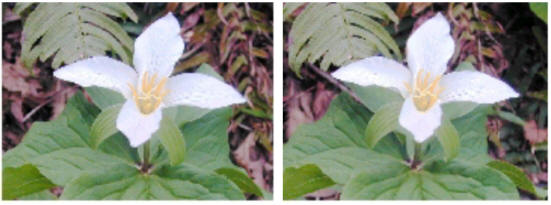(Link to diverging views at bottom of page.)
Because
we can ordinarily cross our eyes much further than we can diverge them,
we can present
much
larger images on a Web browser in eye-crossing than in diverging stereoscopy.

This four-petal trillium
was at the Tryon State Park Trillium Festival this year.
I've place the blossom
in front ot the window and the leaves about at the window.
 ...
...
The Old Maid's Bloomers
(Delicate Arch to NPS)
Arches National
Park (National Monument when the picture was taken)
With this very great
depth from arch to far ridges, the binocular rivalry
is a bit much if
the window is placed near the arch.
In this eye-crossing
pair, I placed the window.at about the ridge in the near distance.
That places the
arch well in front of the window. The larger images allowed by eye-crossing
allows more detail
in Web-based displays.
 ..
..
A ball-and-stick
model of silicon.
Looking down the
[110] direction.
From
a series of stereo photos taken in 1955 at Hughes (Aircraft Co) Semidonductor
materials research laboratory.
.The
picture was taken to be projected onto a aluminum screen for polaroid viewing.
The images were
mounted to place part of the model well in front of the screen.
 ..
..
Grand Teton and Mt
Owen
(or
is that Teewinot)
.This
was taken to illustrate the "See Like a Giant" principle.
It's to show how
much additional information for route finding can be
obtained by using
wide-based stereo pairs.

Single-photo stereoscopic
image
(eye-crossing
only)
Ball-and-stick crystal
model
Simple
cubic space lattice
Stereopsis
results because the view of an adjacent cell is the same
as
the view of the cell itself but from a slightly different angle.